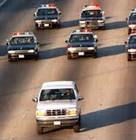 In February 2014, Kern County agreed to pay $8.8 million to settle wrongful
death claims against a deputy sheriff.
In February 2014, Kern County agreed to pay $8.8 million to settle wrongful
death claims against a deputy sheriff.
The settlement stemmed from a December 2011 incident, in which Deputy John Sweringen struck and killed two people in Oildale, a suburb of Bakersfield. Deputy Sweringen was responding to a report of a stolen vehicle; he was travelling at least 65 mph in a 45 mph zone without his lights and/or siren operating. Procedure allows officers to ignore speed limits when responding to a "code 3," but they must be in emergency mode when doing so. 24-year-old Daniel Hiller and 30-year-old Chrystal Jolley were killed as they tried to move a motorcycle across Norris Avenue.
Deputy Sweringen is scheduled to stand trial for two felony counts of vehicle manslaughter with gross negligence later this spring. This sad situation shows the difficult line that officers must tread in responding quickly to reports of crime and following procedure while doing so. Two people are dead and a promising young officer is now facing time in prison because society has decided that the officer was wrong in how quickly to respond to the scene of a crime. As you can probably see, there are two sides to this story as well. Many officers may hesitate too much to use speed, additional crimes may occur and people who need assistance could die. It's a difficult line to walk for law enforcement officers.
This case perfectly illustrates the fine line that police officers walk every day between enforcing the laws and public safety, and the vast majority of officers in Tulare County never, ever cross the line. From 2002 to 2012, 10,000 Californians had been injured, and another 300 killed, during a police high-speed chase. 90% of these incidents involve a nonviolent offense, such as DUI, auto theft and driving with a suspended drivers' license. The California Highway Patrol has defended its officers in such situations, noting that of nearly four million traffic stops in 2011, less than one percent resulted in a high-speed chase.
Nonetheless, beginning in 2006, CHP officially discouraged its employees from engaging in a high-speed chase, because the risk-reward was considered too far out of balance.
Most local law enforcement agencies have followed CHP's lead and taken action to reduce high-speed chases in California, but these potentially deadly events still occur almost every day.
